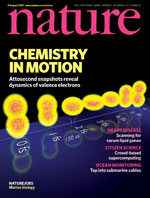If you look at the image of an atom in a text book, it looks rather quiet and peaceful. There is a nucleus in the center made from a number of protons and neutrons. Around the nucleus the electrons typically are shown to orbit the core like planets around the sun.
The reality, however, is far more complicated. First of all, the electrons don’t look like small planets, but are smeared out in complex shapes known as orbitals. The energy states of the different orbitals correspond to the electron shells in atomic physics. And secondly the electron motion is extremely fast, on the timescale of a femtosecond (fs), which is 10-15 seconds. This is so short that even light can’t move very far in such a short time. Within a femtosecond it travels only about a third of a micrometer. So the question is, how is it possible to take a snapshot of such a fast motion? Well, one needs to use a camera that is even faster.
This ‘camera’ is a laser with attosecond resolution. An attosecond (as) is a thousand times faster than a femtosecond. In the present case, pulses of 150 as were used. These lasers are seriously fast. So fast that the light wave in the laser pulse completes only about one cycle. A bit like a tsunami wave that consists of only one big up and downwards motion of the water. Attosecond lasers were pioneered among others by Ferenc Krausz, with the clear aim of using them to venture into the intriguing realm of attosecond science. And it is his group that has now accomplished another major feat: the imaging of electron motions in the outer orbitals of krypton atoms. Their study appears in this week’s Nature, where it was also chosen for the cover.



August 5, 2010
Comments Off on Close encounters with outer shells